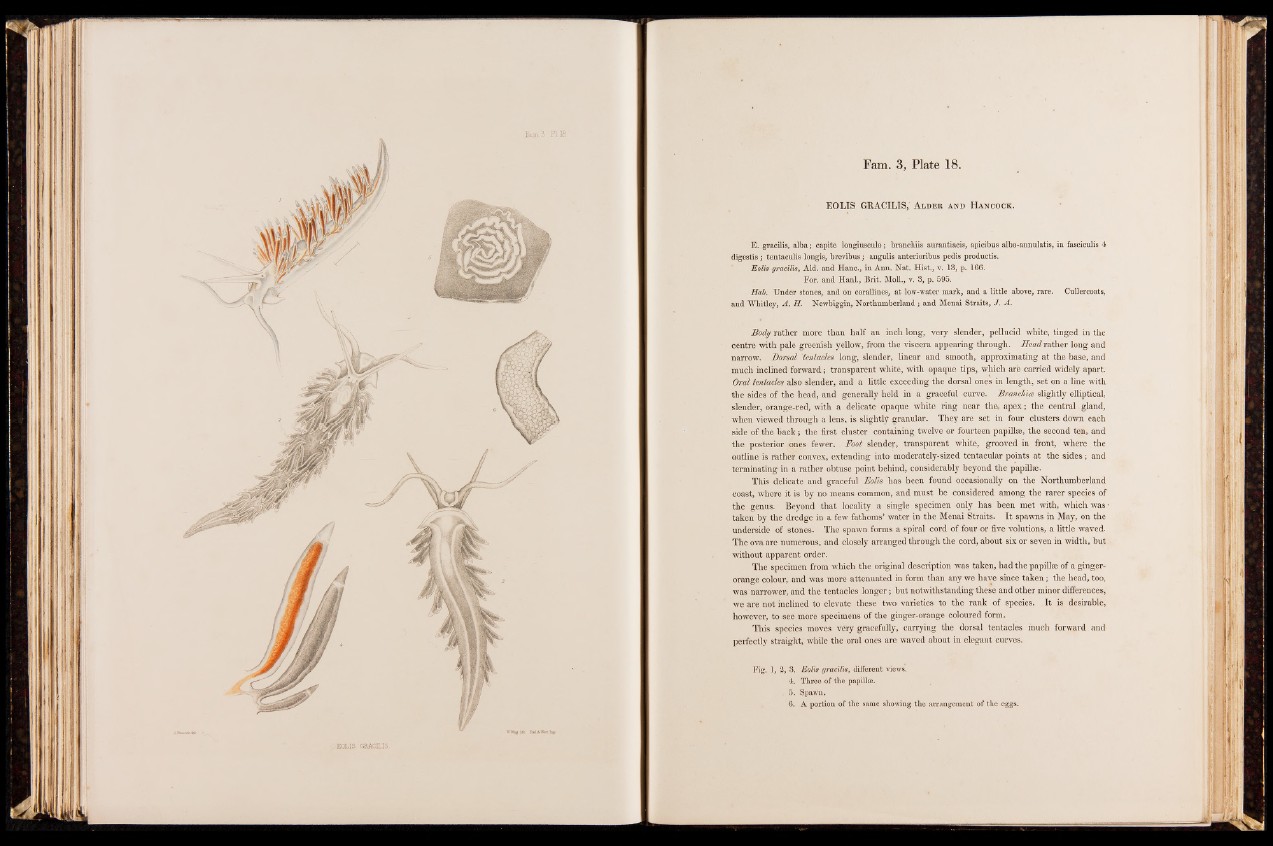
EOLIS GRACILIS.
EOLIS GRACILIS, Alder and Hancock.
E. gracilis, alba; capite longiusculo; branchiis aurantiacis, apicibus albo-anmilatis, in fasciculis 4
digestis ; tentaculis longis, brevibus; angulis anterioribus pedis .productis.
Eolis gracilis, Aid. and Hanc., in Ann. Nat. Hist., v. 13, p. 166.
For. and Hanl., Brit. Moll., v. 3, p. 595.
Hab. Under stones, and on corallines, at low-water mark, and a little above, rare. Cullercoats,
and Whitley, A. H. Newbiggin, Northumberland; and Menai Straits, J. A.
Body rather more than half an inch long, very slender, pellucid white, tinged in the
centre with pale greenish yellow, from the viscera appearing through. Head rather long and
narrow. Dorsal tentacles long, slender, linear and smooth, approximating at the base, and
much inclined forward; transparent white, with opaque tips, which are carried widely apart.
Oral tentacles also slender, and a little exceeding the dorsal ones in length, set on a line with
the sides of the head, and generally held in a graceful curve. Branchiae slightly elliptical,
slender, orange-red, with a delicate opaque white ring near the, apex; the central. gland,
when viewed through a lens, is slightly granular. They are set in four clusters down each
side of the back; the first cluster containing twelve or fourteen papillae, the second ten, and
the posterior ones fewer. Foot slender, transparent white, grooved in front, where the
outline is rather convex, extending into moderately-sized tentacular points at the sides; and
terminating in a rather obtuse point behind, considerably beyond the papillae.
This delicate and graceful Bolts has been found occasionally on the Northumberland
coast, where it is by no means common, and must be considered among the rarer species of
the genus. Beyond that locality a single specimen only has been met with, which was •
taken by the dredge in a few fathoms' water in the Menai Straits. It spawns in May, on the
underside of stones. The spawn forms a spiral cord of four or five volutions, a little waved.
The ova are numerous, and closely arranged through the cord, about six or seven in width, but
without apparent order.
The specimen from which the original description was taken, had the papillae of a ginger-
orange colour, and was more attenuated in form than any we have since taken; the head, too,
was narrower, and the tentacles longer; but notwithstanding these and other minor differences,
we are not inclined to elevate these two varieties to the rank of species. It is desirable,
however, to see more specimens of the ginger-orange coloured form.
This species moves very gracefully, carrying the dorsal tentacles much forward and
perfectly straight, while the oral ones are waved about in elegant curves.
Fig. 1, 2, 3.
4.
5.
6.
Eolis gracilis, different views.
Three of the papillae.
SpaWn.
A portion of the same showing the arrangement of the eggs.